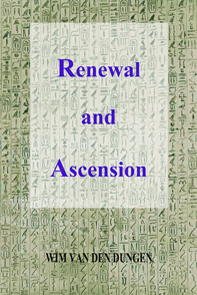|
With
the mythological symbol of the Eye, we touch upon what has been called
"the key to the religion" (Clark,
1959, p.227).
It is also the most complicated of Egyptian symbols. The two Eyes (one in
the primeval waters and one in the ideal society) was the most common & popular symbol in Egyptian thought. But even
before
the Dynastic Period, both in Asia and Europe, an eye or eyes represented a
Neolithic fertility goddess. The general word for "eye" in
Egyptian is "irt" (pronounced "eeret"), a feminine
noun.
To grasp the meaning of the Eye, two registers can be
invoked. However, in Egyptian pre-rational thought, these levels are often
confused, whereas there is a semantic bridge between both registers :
-
the
Eye is a cosmogonic goddess, symbol of reunification and divine
kingship : this is the Single Eye of the Supreme,
Self-created High God of before creation, namely Atum. This Eye is
also called the "Eye of Re" and the "Eye of Horus"
(the Elder), associated with the right hand side, the summer and the
Sun. Its mythical activity (like that of the autocreation of Atum and
the family drama of Osiris) took place in
the "first time", the so-called "zep tepy" ("zp tpy") or "Urzeit".
-
the
Eye is an anthropological symbol of restoration and popular wellness
:
this is the Restored Eye of Horus, son of Isis and Osiris, the
"Wedjat" ("wDAt" : hale or uninjured), associated
with the left hand side, the winter and the Moon. Because Thoth played
an important role in its myth, it is also called the "Eye of
Thoth".
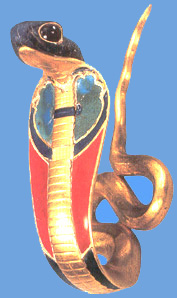
golden uraeus of Wadjet
XIIth Dynasty - Senwosret I
► Register
1 : Single
Eye - Enraged Eye - Pacified Eye
From the
IIIth Dynasty (ca. 2670 - 2600 BCE), we have evidence for an emphasis on a
single creator, although its cult is rooted in the Early Dynastic Period. At the cult centre of the sun god Re at Iunu or
Heliopolis, the most solar of all symbols was the tip of the pyramid, the
"benben" stone, shining in the light of the sun. This
represented the rock of the primeval mound, the first dry land, which had
risen at Iunu when the "first time" had come to a close (namely
with the actual, physical creation of the world). Heliopolitan theology
was Pharaonic. The king was identified with the son of Re and thus the
only deity actually alive on Earth. This new justification of the king's
power to unify Egypt involved his deification. No longer an incarnation
(personification) of the High God of the "Followers of Horus"
(the Elder), Pharaoh was a god himself. He assimilated the power of the
Predynastic fertility & sky goddess (such as Hathor). This goddess can
also be identified as the Single Eye of Atum transformed by this bisexual
deity ("I am these Two, male and female"
- CT, spell 136)
in the royal cobra bound around Re's crown (and by extension, around that
of Pharaoh, his son).
In a prayer for Pharaoh and his pyramid, we find :
"O Atum-Khoprer !
You became high on the height ! You rose up as the Benben stone in the
Temple of the Phoenix in Iunu. You spat out Shu, You expectorated Tefnut. You set your arms about them as the arms of a Ka-symbol, that your
Ka power might be in them."
Pyramid Texts,
utterance 600, § 1652.
With the coming of the sacred bird, who delivers the message of life, the
first light becomes visible after the rising of the primordial hill. Before that singular event, two precreational
strata were at work to prepare creation :
-
the
"Nun" ("nwn")
: the primordial, abyssimal, chaotic
"Untergrund" : this is the basic principle of Egyptian
thought, common to all major accounts of the origin of creation.
Before creation, these primeval waters were everywhere, stretching
endlessly in all directions and subject to no temporal changes. This
negative precreational realm is an undifferentiated, dark, chaotic,
limitless expanse. The present cosmos is a cavity, an island or
air-bubble of order amid these waters, which extend above as well as
below. This vast ocean of the chaos of non-being, passivity, inertness
and unconsciousness, is thus to be met at the limits of the known
(below the Earth and above the sky).
-
the
"zep tepy" ("zp tpi")
: the primordial, "Urzeit",
"first time" and "first matter", is before creation and represents a mythical isthmus between
total negation of being (the underground) and creation (the emergence
of the primodial hill), to
be situated in the primordial waters. This time of no-time
"started" when Atum created himself in the midst of the Nun
(the first generation of the Sole Lord). Moreover, his coming into
being in the waters coincided with the emergence of life (his son Shu)
and order (his daughter Tefnut), either by spitting, expectoration or
masturbation. This was the second generation of gods.
Apparently,
at some point after having created Shu and Tefnut, Atum was alone in the "zep tepy". Total relaxation surrounded
him and this made him "very weary" (CT, spell 80). At
this point he dispatched his Sole Eye (CT, spell 262) to bring Shu
and Tefnut back to him so as to be reunited with them. Shu and Tefnut,
mere exhalations of Atum, were indeed helpless in the endless waters. The Eye was
able to defend them on their dark, dangerous journey back to their maker and renunite
the divine. But when the Eye searched and had fetched what
it sought (CT, spell 331), it became enraged because Atum had put
another eye in its place (Bremner Rhind Papyrus).
To pacify the Eye, Atum changed it into a rearing cobra with swollen neck,
the uraeus snake guarding Re's crown, protecting it and
guaranteeing the endurance of his monarchy. This snake is a defensive
cobra, called "iaret" ("iart" - "she who
mounts") or "uraeus", rearing up to strike with lethal
force any enemy of Pharaoh. This Lower Egyptian cobra-goddess was also called
"Wadjet" ("wDt").
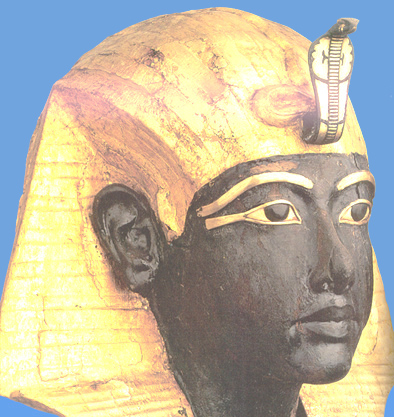
With the Sole Eye of Atum transformed into the uraeus of Re's crown,
the theogonic phase of the "zep tepy" was over, namely the
Self-creation of Atum, simultaneous with the coming into being of Shu and
Tefnut and his subsequent coronation thanks to the Single Eye fetching
back his children. The third generation of gods (Geb and Nut) constitute the
mythical geosphere (Earth and sky), whereas the fourth generation of gods (Seth,
Nephthys, Osiris and Isis) constitute the mythical
"perfect" kingdom or "golden age". This Osiris
enherited from Re, who withdrew to abide in the sky.
The emergence of the primordial
hill at Heliopolis (the actualization of the myth in the history of the
world) was deemed to be the physical, spatiotemporal (historical)
manifestation of all these mythical elements : Atum became ("kheper" - "xpr"), the
manifestation of light ("Re" - "rA"). The sun was called "Atum" at
dusk, "Osiris" at night, "Khepri" at dawn and
"Re" at noon. The constitution of the "face" of divine
kingship and the actual emergence of the physical world at Heliopolis happened
simultaneously (as Atum, Shu and Tefnut had come into being together in
the waters). The rage and violence of the Eye had been Atum's motivation to change it
and bind it as a snake around the crown (suggestive of the protection of order
by knowing its boundaries) and raising it at the brow of the Lord of Light, Re,
who's son was the royal Pharaonic manifestation of
Atum in the kingdom of order, constantly surrounded by the ocean of non-being,
negativity, destruction & annihilation.
"Take the two
Eyes of Horus, the black and the white. Take them to your forehead, (so)
that they may illuminate your face." -
Sethe,
1908/1960, § 33a
But the beautiful face of Re, as well as of Pharaoh, had two eyes.
Its right (left) eye was associated
with the Sun (Moon). The Solar Eye of Re (or Eye
of Horus the Elder) referred to the Sole Eye Atum had transformed into the uraeus
snake. This right Eye was the "white eye", associated with
the cycle of the Sun (especially its zenith) and with the summer. It was this
ever intact eye which was used in the Egyptian notation of measures of capacity
:
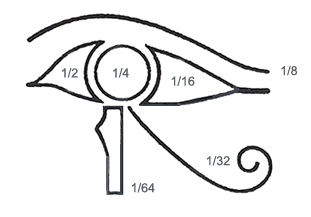
the
uninjured Eye of Re or Eye of Horus the Elder
the sum of the fractions is 63/64 - 1/64th was left to magic
► Register
2 : left Eye
of Re, Eye of Horus, Eye of Thoth, Wedjat Eye
The left
Eye of Re was also called the Eye of Horus, son of Isis, the Wedjat Eye or
Eye of Thoth.
"To say :
'Horus has cried out because of his Eye, Seth has cried out because of his
testicles. The Eye of Horus sprang up, as he fell on yonder side of the
Mer-en-Kha {a lake in the Netherworld}, to protect itself from Seth. Thoth
saw it on yonder side of the Mer-en-Kha when the Eye of Horus sprang up on
yonder side of the Mer-en-Kha and fell on Thoth's wing on yonder side of
the Mer-en-Kha.' "
Pyramid Texts,
§ 594a -f
"Behold, Pharaoh
Unis brings to You your great left Eye healed. Accept it from Pharaoh Unis
intact, with its water in it intact, with its blood in it intact, and with
its ducts in it intact."
Ibidem,
§ 451a - c
"To say : 'O my
father, Pharaoh Merenre, I have come and I bring to you green eye-paint. I
bring to you the green eye-paint which Horus gave to Osiris. I give you
{the eye-paint is addressed} to my father, Pharaoh Merenre, just as Horus
gave you to his father Osiris. Horus has filled his empty Eye with his
full Eye.' "
Ibidem, §
1681 - 1682
In the fight with Seth, Horus lost his left eye (and Seth his testicles -
symbols of the causes of revolt, violence, sexual perversity and turbulence). This left
Eye
of Horus is the endangered & injured Eye, also
called "the black eye" (his "empty Eye" torn out), associated
with the cycle of the Moon (its destruction is associated with the New
Moon, its restoration with the Full Moon). It was miraculously filled and completed by Thoth and then
given back to Horus (as it is brought to Pharaoh) as a "full
Eye" or "Eye of Thoth".
"Although
Maat may have been driven out, she could return thanks to the assiduous
work of the ruler or the individual. In that sense maat resembled
the eye of Horus, wounded time and time again and subsequentely healed.
Both symbolized a constantly endangered order that must repeatedly be
established anew. The presentation of the eye of Horus, or udjet eye, by
the pharaoh or priest had the same basic significance as the presentation
of Maat. The gesture gave visible proof that all disruptions and threats
to order had been removed, and that justice and harmony ruled once more.
On two statues we find the symbols explictly joined in the inscription :
'My arms carry the udjet eye, I present maat.' The sacred
eye is often shown in the hands of a baboon - an allusion to Thoth, who
healed the eye ..."
Hornung,
1992, p.142.
Because of this rejuvenation, it is called "the green
eye" (cf. the color of the resurrection of Osiris also associated
with vegetation). When healed, it even had its own
typical perfume.
|
NUN
|
the
preexistent, primordial, precreational waters which lurk behind
every excess of the floods ... |
passive
chaos of precreation |
|
APOPHIS |
the impersonal evil of precreation, totally destructive and
negative, to be avoided at all costs - intends the annihilation of
the order of creation, tries to swallow the water of the Nile to
stop Re |
active
chaos of precreation |
|
SETH
|
the arch-personalization of divine evil - fundamental cause of the
disruption of divine plenty and (by extension) of the "breaks"
between various "states" of the heart - controls Apep the serpent |
active
chaos
universal
evil part of creation |
|
ISEFET
|
the
negation of Maat by the members of the pantheon (like Seth), and
general concept for all possible moral evil done by the person and
his (her) heavy heart |
active
chaos
personal
evil |
With the
Eye of Horus, we touch upon the core of the dramatical activities
unfolding between the gods & goddesses, as these are determined by the
presence of Seth, the personalized focus of the active chaos within
creation : divine, natural as well as moral (deicide, calamity & moral
evil, i.e. "isefet").
The scarcely mentioned murder of Osiris by
Seth, was the introduction of divine moral evil in the holy sanctuary of
the pantheon itself : chaos initiated as an intrinsic, irreducible and
active part of the system of nature (contrary to Nun, who remains passive
and undifferentiated, Seth has a form of expression of his own) ... The
result was devastating, for the old order (represented by Osiris) was over
(he was slain).
With the "mourning of Isis" came the necessary
purgation enabling Isis to trick Re into giving up his secret,
creative name.
Together with Thoth she was able to resurrect Osiris in a new, immortal
body in the Netherworld, were he reigned as supreme king and judge. But
before that, Isis and Osiris conceived a son called Horus, who avenged his father by
combatting Seth, and lost his left eye. He was justified (not by winning
the battle) but by the concert of the divine tribunal and so became the
Lord of the Two Lands. Seth was not destroyed, but had to retreat in the
dry deserts, with its storms and weird animals. As compensation for
abandoning the throne, Seth was given two goddesses as wives and was
also allowed to live in the desert. Every night, his magical strength
was needed when Re, at the end of the nightly caverns (reviving Osiris at
the midpoint of the night), was attacked by Apep, the great chaos serpent.
Hence, Seth was fully integrated although he remained the arch-fiend.
The restoration of the Wedjat Eye (by Thoth) is reminiscent of the resurrection
of Osiris (cf. the "green" eye). The Eye of Horus represented
the last, final phase of the drama, one with which everybody could easily
identify when calamity, conflict, disease or some other evil occurred
(Osiris, Isis & Horus function as a family-unit). The restoration of
the Eye reflected the reequilibration of Maat on a personal, intimate,
contextual level just as the pacification of the enraged Eye had heralded
the beginning of the emergence of the primordial hill and divine kingship.
To present the Eye of Horus, was to offer one's
efforts to turn away from the Sethean towards the Osirian. This was doing
Maat on a personal & social level (for offerings were always
redistributed).
The fact the Wedjat Eye was restored while Horus was alive, made it possible
to associate its "emptiness" with a sickness (a lack) of which
one is healed (completed, made full). Did the healer (another function of
Thoth), restored what was sick by applying "green" or
"vitality" ? When the Eye had been restored, it became more
powerful than before (stronger immunity). Restored, it became the magical
Eye par excellence, tracing its enemy with the "night-eye" of
darkness (in dreams, visions) as well as with the "day-eye" of
inner vision (in controlled trance, telepathy and clairvoyance). The eye
of the high priests, the visionary prophets ...
"To the Egyptians, the archetypal amulet was the wedjat eye,
from which one of the general words for amulet was derived. Rubrics often
mention that the wedjat eye should be drawn on linen or papyrus for
use as a temporary amulet. Thousands of examples in more permanent
materials survive." -
Pinch,
1994, p.109.
To illiterate Egyptians, the restoration of the Eye of
Horus was the analogon of what the resurrection of Osiris meant for
Pharaoh and those deified with him. It also pointed to the return of Shu
and Tefnut to Atum, who embraced them to rejuvenate them with his
Ka-power. The first pair were therefore not really powerful until the
Single Eye could return them to their creator.
By adhering to the Eye, commoners
realized a continuous awareness (conscience) also implied in the image of
the balance with its plumb-line. Was the popular (amuletic &
talismatic) image of the Eye, besides being protective, also at work as a
common reminder to be alert, mindfull, aware, present & observant of
what is happening (cf. "ayin", the "eye" in qabalah),
i.e. to avoid disease and unbalance ? These attacks on Maat, cause breaks
in the stream of consciousness, or Sethean gaps, which have to be restored
afterwards, again by witnessing its flow, measuring its disposition and
rebalancing, assisted by rituals & voice-offerings ...
"The Eye is
personified might, the essential violence that is used to protect the gods
and kings against disintegration in the waters or spirit enemies in the
created world." -
Clark,
1959, p.93.
► the
beautiful face : the two Wedjat Eyes
Both
complex mythological processes related to the Two Eyes "happen"
in the "zep tepy". The Single Eye represented the cosmological,
theological, royal register, whereas the Wedjat Eye had anthropological,
social and popular connotations. The Single Eye deals with the first and
second generation of gods. The Wedjat Eye with the last generation of gods. Before creation, only one sacred Single
Eye existed. After creation, Pharaoh's two eyes watched the world. His
right, Solar Eye is the Eye of Re (theological), his left, Lunar Eye is
the Eye of Horus, or Eye of Thoth (anthropological). Hence, Pharaoh's
beautiful face was a balanced expression of all major precreational,
mythical "events". In his coronation at Memphis, all
constitutive elements of divine kingship came together and "the
beautiful face" (epithet of Ptah of Memphis) was established.
The cobra-goddess Wadjet on Pharaoh's crown, like the plummet of the
balance, defended the borders of the world to allow Pharaoh to establish
Maat. The rising cobra helped Pharaoh to discriminate between order and
chaos and to pacify the land (by encircling its limits -bound around the
crown- and establising the boundaries of the world). She was the great
goddess, strong and powerful in magic, that made Pharaoh balance the
scales : at one side the divine rule (Maat, the perfect right Eye) and at
the other the human rule (Osiris, the restored left Eye).
Atum's loneliness is interesting. After creating Shu and Tefnut, the
latter generated Geb and Nut, followed by Osiris, Isis, Seth & Nephthys,
closing the Heliopolitan Ennead. The murder of Osiris is also one of the
mythical events eternalized "in the beginning", in this place of
no-place at a time of no-time. The "zep tepy" was conceived as before
creation (the emergence of the primordial hill, the first light and the
first united kingdom) but after
ultimate darkness & limitness nothingness (the Nun). The quest of
the Single Eye is the mytho-cosmological phase of this precreational sequence. By
bringing back Shu and Tefnut to Atum (cf. the saga of the return of the
conquering hero), the Enraged Eye restored the divine power of Atum in
the "zep tepy". Her reward ? A transformation of form. This
heralds the final emergence of the "air-bubble" of order (the
divine kingdom of unity of Re) within the vast expanse of chaos surrounding it in every
possible direction.
The rage of the Single Eye was cooled by changing it into Re's royal
cobra. With the celestial coronation of
Re, the actual world was preformated to be ruled by a divine king,
who guaranteed all hostile forces would be driven away and unity
would prevail. Re withdrew to the sky and left the mythical Two Lands to
Geb. Only when the drama befalling the fourth generation of gods was
over, did the eyes of Re
became the eyes of Pharaoh. Pharaoh's Solar Eye was perfect (as was the
original Single Eye before its quest) and his Lunar
Eye was restored. This allowed him, and him alone, to return Maat to Re and
guarantee enduring life, prosperity and health for all of Egypt.
Indeed, the divine face of Pharaoh, the Lord of the Two Lands, made both myths
converge :
Re was crowned in the sky because Atum, hidden in the "zep tepy", pacified the Enraged Eye that had toiled for Atum's family
reunion. The original Single Eye of Atum (before her quest) is Pharaoh's right
Eye or Eye of Ra, for he, the terrestial king, is the
sole son of the celestial king. Moreover, he too goes, like the Single Eye, to the outward limits of the
world (read : Egypt) to establish the boundaries. He brings back whatever
he needs for the monumental elaboration of the unifying presence of the divine in
the Two Lands, represented by his crown and protected by the cobra goddess
Wadjet. His rejoicing is the rejoicing of the
land. His omnipresence is like Atum's Ka-giving to his returned children.
Because of his perfect Eye, Pharaoh is able to address the deities.
Because of the cobra (the Enraged Eye pacified), his enemies are subdued. This
explains his theological imperative : all rituals are in his name. He is
the sole priest able to address his father and the other members of his
celestial family.
But Pharaoh is also Horus, son of Isis and Osiris, who had his left Eye
torn out and thrown away by Seth. It was found & restored by Thoth.
Horus was crowned king by the celestial Ennead. Here we have his
theocratic imperative : Pharaoh has the Wedjat Eye and is therefore the
ultimate authority on all matters, the good sheperd who knows the way, the
righteous king who cares for his people, etc.
Because a "great house" was present in the Two Lands, the
deities allowed their Ka-power and souls ("bA") to dwell in
their golden statues, put away safely in the hidden sanctuaries of the
temples built by Pharaoh. There, he or his representatives would daily
offer Maat to his father Re. The Egyptians believed that by doing so,
Pharaoh assured unity, justice and enduring material plenty (cf. balanced
Nile floods, for too much or too little water caused calamities).
So, in the Heliopolitan scheme, we observe the following sequence of Solar symbols
take form :
-
Atum : the self-created, hidden godhead, alone and reunited with his
family ;
-
Khepri : Atum manifesting the world ;
-
Re
: Atum present in the world, but withdrawn in the sky ;
-
Horus
(the Elder) : the power of the sky (where Re abides) ;
-
Horus
(son of Isis & Osiris) : the divine king who unites the Two
Lands and restores all unbalance thanks to his Wedjat Eye, or healing
power.
The
mythical cycle of the Single Eye (on an errand, enraged, pacified)
parallels that of the Wedjat Eye (torn out, in pieces, restored).
Away from the original positive state
: both eyes are driven out of
their original situation (of oneness with their creator). The Single Eye,
the great goddess and daughter of Atum, has to probe ultimate darkness in
search for Atum's firstborns. The left eye of Horus is torn out in a
violent battle with the arch-fiend of order, Seth.
Into the negative crisis state : both eyes are active negatives :
the daughter of Atum becomes enraged and although changed in a cobra and
pacified, never lost all of her violence & rage. But, this deadly
wrath is put into service of the protection of the crown. The eye of Horus
was cast into the Netherworld and broken into pieces !
Into a new positive state
: both eyes are transformed
("kheper" - "xpr") in such a way their original
powers are reinforced by the mastered negativity. The Enraged Eye becomes
the terrible protective royal cobra Wadjet. The restored eye is the Wedjat Eye, the
most powerful healing instrument ever, for with it, Horus resuscitated
Osiris, who resurrected to become the spirit of life itself. The Wedjat
Eye brought enough Ka-power (just as Atum's embrace gave Ka-power to Shu
and Tefnut) to heal any injury and to allow the natural motion of the soul
to be restored. This brings the soul to the sky, where it will
spiritualize in unity with its spirit (or essence of the soul).
There is a clear parallel between, on the one hand, the task of the Single
Eye and, on the other hand, that of the Eye of Horus :
THE
HELIOPOLITAN
ENNEAD |
THE
DIFFERENTIATION OF THE DIVINE EMERGING OUT OF ABSOLUTE TOTALITY |
FIRST
Generation |
THEOLOGICAL |
|
ATUM |
the
sole principle of the totality of the Divine encompassing all
theophanies |
SECOND
Generation |
COSMOLOGICAL |
| SHU
- TEFNUT |
the
totality of the Divine splits into life and order |
| the
Single Eye closes this stage of generation - Re is crowned |
THIRD
Generation |
GEOGRAPHICAL |
| GEB
- NUT |
Earth
and sky are the conditions of existence : Re shines between
both |
FOURTH
Generation |
SOCIETAL |
| OSIRIS
- ISIS |
the
perfect Divine family pacifies the Two Lands - it brings &
offers order |
| SETH -
NEPHTHYS |
the
arch-fiend of truth ticks Osiris & assails the offspring of
goodness |
| the
Wedjat Eye of the crowned Horus restores Osiris' vital force |
Both cycles converge in Pharaonic theology, the justification of
the divine nature of Pharaoh, who mastered and made good use of Seth. This
guaranteed the endurance of order. The Single Eye resulted in the
coronation of Re. The Wedjat Eye led to the ultimate spiritualization of
Orisis, rising as a soul to the sky and returning as the spirit of life,
vegetation, fertility and the overall "resurrection" of nature
with the New Year.
In the fourth generation of gods, conflict arose. The birth of Seth
marked the end of a harmonious unfoldment of the Ennead. The Osiris -
Seth drama and Horus - Seth conflict represented the fundamental
tensions between goodness and wickedness, between straightness and
crookedness. These are at work, in the cosmos as a whole, in every human
society and in every individual.
This coming of the new floods symbolically represented (and repeated)
the coming into existence of the worldly order, the political
establishment of the "great house", the Dynastic Pharaonic
rule of Horus, who unified the Two Lands and finally brought the
mythical period to a closure. Hence, the mythical stage of the world and
Predynastic Egypt, with its divisions and turbulence, were akin.
|
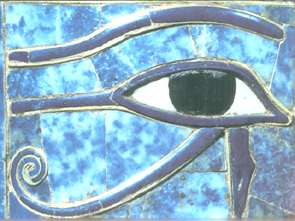
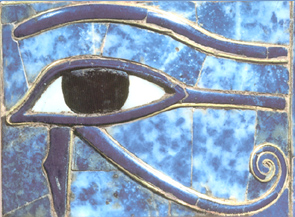
![]()
